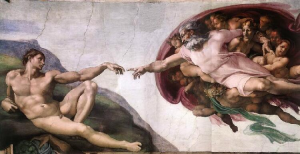Native American Creationists
by Heather Pringle
August 22, 2008
 When a fundamentalist Christian organization, Answers in Genesis, opened a Creation Museum in Petersburg, Kentucky, in May 2007, scientists were quick to weigh in with their criticism. The Answers in Genesis organization believes, according to its website, that the Bible is “the history book of the universe,†providing “a reliable, eyewitness account of the beginning of all things.†Moreover, it claims that the Bible “can be trusted to tell the truth in all areas it touches on.â€
When a fundamentalist Christian organization, Answers in Genesis, opened a Creation Museum in Petersburg, Kentucky, in May 2007, scientists were quick to weigh in with their criticism. The Answers in Genesis organization believes, according to its website, that the Bible is “the history book of the universe,†providing “a reliable, eyewitness account of the beginning of all things.†Moreover, it claims that the Bible “can be trusted to tell the truth in all areas it touches on.â€
Not surprisingly, the organization roundly rejects evolution, and its strict adherence to the Biblical creation story produced some very strange museum exhibits. One gallery, for example, placed a model of a Jurassic dinosaur, Stegosaurus,  on the deck of Noah’s Ark—much to the dismay of the National Center for Science Education (NCSE). “Students who accept this material as scientifically valid are unlikely to succeed in science courses at the college level,†noted a NCSE statement. “These students will need remedial instruction in the nature of science, as well as in the specific areas of science misrepresented by Answers in Genesis.â€
The concerns over the Creation Museum may seem a little remote from archaeology, but I have become increasingly worried in recent months over the rise of a different but no less worrying brand of creationism—a strict belief in the origin stories of Native Americans.
These stories vary widely from tribe to tribe, but many describe a similar sacred narrative. A female creator falls from the sky at the beginning of time, when water covers the earth. To create forests and meadows, animals dive to the bottom to bring back mud. When one finally succeeds, sky woman pats this muck on the back of a turtle, and creates both land and the first humans. This Turtle Island, say the storytellers, is North America.
Handed down by generations of elders, these stories are rich in metaphor and poetry. But lately I have heard educated young Native Americans take a surprisingly hard line on them, describing their elders’ stories as reliable accounts of the beginning of the world and insisting that their ancestors were “always†here in North America.
I think this is a worrying development. It rejects out of hand a mountain of archaeological, linguistic and DNA evidence showing that the first Native Americans were Asia migrants who trekked on foot across the vast grasslands of Beringia or paddled in boats along the northern Pacific rim more than 13,000 years ago. And it panders to an increasingly strident strain of anti-science in our society.
Many archaeologists have been reluctant to take Native Americans to task on this. They know all too well how aboriginal tribes suffered from the suppression of traditional spirituality by white missionaries and others in the past. But I don’t think archaeologists can afford to turn a blind eye to this new creationist challenge. Let me tell you why.
Chris diCarlo, a sessional lecturer at Sir Wilfrid Laurier University in Ontario, turned up at class one day in 2005 wearing a T-shirt saying “We are all Africans.†DiCarlo was teaching a course on critical thinking, and he planned to discuss the Out of Africa theory, which suggests that all modern humans originated in Africa some 200,000 years ago. During his lecture, diCarlo, a former visiting research scholar in Harvard’s Department of Anthropology and the Peabody Museum of Archaeology and Ethnology, carefully presented the evidence for this theory. But an aboriginal student took offence at the material. She approached him after class, and apparently told him pointblank that “My people don’t believe what you are saying.†She also lodged a complaint with the university. As a result, diCarlo, who had previously been shortlisted for a full-time teaching position at the university, was passed over.
DiCarlo has now bounced back from all this. He is currently an assistant professor at the University of Ontario Institute of Technology, and in 2008 he won the province’s Best Lecturer Award. But the morals of the story are clear to me: archaeologists can’t afford to pay lip service to stories any more at the expense of science. And they need to better engage the public with the real evidence of archaeology.
Comments posted here do not represent the views or policies of the Archaeological Institute of America.






 Heather Pringle is a freelance science journalist who has been writing about archaeology for more than 20 years. She is the author of Master Plan: Himmler's Scholars and the Holocaust and The Mummy Congress: Science, Obsession, and the Everlasting Dead. For more about Heather, see our
Heather Pringle is a freelance science journalist who has been writing about archaeology for more than 20 years. She is the author of Master Plan: Himmler's Scholars and the Holocaust and The Mummy Congress: Science, Obsession, and the Everlasting Dead. For more about Heather, see our 



